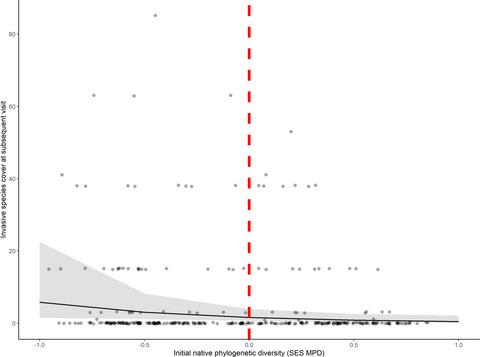Our official English website, www.x-mol.net, welcomes your
feedback! (Note: you will need to create a separate account there.)
The invasion paradox dissolves when using phylogenetic and temporal perspectives
Journal of Ecology ( IF 5.3 ) Pub Date : 2021-11-10 , DOI: 10.1111/1365-2745.13812 Adrienne R. Ernst 1, 2 , Rebecca S. Barak 2 , Andrew L. Hipp 3 , Andrea T. Kramer 2 , Hannah E. Marx 4 , Daniel J. Larkin 5
中文翻译:

当使用系统发育和时间视角时,入侵悖论消失了
更新日期:2021-11-10
Journal of Ecology ( IF 5.3 ) Pub Date : 2021-11-10 , DOI: 10.1111/1365-2745.13812 Adrienne R. Ernst 1, 2 , Rebecca S. Barak 2 , Andrew L. Hipp 3 , Andrea T. Kramer 2 , Hannah E. Marx 4 , Daniel J. Larkin 5
Affiliation

|
- The prediction that higher biodiversity leads to denser niche packing and thus higher community resistance to invasion has long been studied, with species richness as the predominant measure of diversity. However, few studies have explored how phylogenetic and functional diversity, which should represent niche space more faithfully than taxonomic diversity, influence community invasibility, especially across longer time frames and over larger spatial extents.
- We used a 15-year, 150-site grassland dataset to assess relationships between invasive plant abundance and phylogenetic, functional and taxonomic diversity of recipient native plant communities. We analysed the dataset both pooled across all surveys and longitudinally, leveraging time-series data to compare observed patterns in invasion with those predicted by two community assembly processes: biotic resistance and competitive exclusion. We expected more phylogenetically and functionally diverse communities to exhibit greater resistance to invasion.
- With the pooled dataset, we found support for the long-standing observation that communities with more native species have lower abundance of invasive species, and a more novel finding that more phylogenetically diverse communities had higher abundance of invasive species. We found no influence of aggregate (multivariate) functional diversity on invasion, but assemblages with taller plants, lower variability in plant height and lower seed mass were less invaded. Viewed longitudinally, the phylogenetic diversity relationship was reversed: the most phylogenetically diverse communities were most resistant to invasion. This apparent discrepancy suggests invasion dynamics are influenced by both site attributes and biotic resistance and emphasizes the value in studying invasion across time.
- Synthesis. Our results provide insight into the nuances of the diversity–invasibility relationship: invasion dynamics differed for different dimensions of diversity and depending on whether the relationship was evaluated longitudinally. Our findings highlight the limitations of using single time-point ‘snapshots’ of community composition to infer invasion mechanisms.
中文翻译:

当使用系统发育和时间视角时,入侵悖论消失了
- 长期以来,人们一直在研究更高的生物多样性导致更密集的生态位堆积并因此具有更高的群落对入侵的抵抗力的预测,其中物种丰富度是多样性的主要衡量标准。然而,很少有研究探讨系统发育和功能多样性(应该比分类多样性更忠实地代表生态位空间)如何影响群落的不可侵入性,特别是在更长的时间框架和更大的空间范围内。
- 我们使用 15 年、150 个地点的草原数据集来评估入侵植物丰度与受体本地植物群落的系统发育、功能和分类多样性之间的关系。我们分析了所有调查和纵向汇总的数据集,利用时间序列数据将观察到的入侵模式与两个群落组装过程预测的模式进行比较:生物抗性和竞争排斥。我们预计更多的系统发育和功能多样化的群落对入侵表现出更大的抵抗力。
- 通过汇集的数据集,我们发现支持长期观察,即具有更多本地物种的社区具有较低的入侵物种丰度,以及更新颖的发现,即系统发育更多样化的社区具有更高的入侵物种丰度。我们发现聚合(多变量)功能多样性对入侵没有影响,但具有较高植物、较低植物高度变异性和较低种子质量的组合受到的入侵较少。从纵向来看,系统发育多样性关系是颠倒的:系统发育最多样化的群落对入侵的抵抗力最强。这种明显的差异表明入侵动态受到场地属性和生物抗性的影响,并强调了跨时间研究入侵的价值。
- 合成。我们的结果提供了对多样性 - 可入侵性关系的细微差别的洞察:入侵动态因多样性的不同维度而异,并且取决于是否纵向评估了这种关系。我们的研究结果强调了使用社区组成的单个时间点“快照”来推断入侵机制的局限性。











































 京公网安备 11010802027423号
京公网安备 11010802027423号